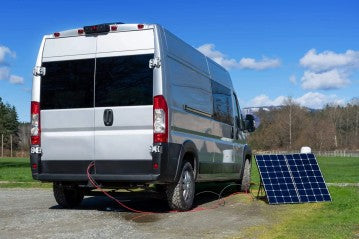
Deep Cycle Battery Basic Guide
Deep cycle batteries play a crucial role in various applications, providing reliable and long-lasting power storage solutions. Whether you're powering solar energy systems, marine vessels, or electric vehicles, understanding deep cycle batteries is essential for optimizing their performance and longevity. In this blog post, we will explore the ins and outs of deep cycle batteries, including their definition, working principle, different types, maintenance and why they are a preferred choice for many applications.
1. What Is a Deep Cycle Battery?
A deep cycle battery is a type of rechargeable battery specifically designed for deep discharge and recharging cycles. Unlike starter batteries, which provide a high burst of energy for starting engines, deep cycle batteries are built to deliver sustained power over extended periods. They are characterized by their ability to discharge a significant portion of their capacity while maintaining their performance and longevity.
2. How Does a Deep Cycle Battery Work?
Deep cycle batteries work through a chemical reaction that converts stored chemical energy into electrical energy. They typically consist of lead-acid or lithium-ion cells, where the charging and discharging processes occur.
During charging, an external power source applies a higher voltage to the battery, causing an electrochemical reaction. This reaction reverses the chemical process that occurred during discharge, converting electrical energy back into stored chemical energy. As a result, the battery becomes fully charged and ready to provide power.
When the battery discharges, the chemical reaction is reversed, converting stored chemical energy into electrical energy. Deep cycle batteries can handle repeated cycles of charging and discharging without significant degradation, making them ideal for applications that require sustained power over an extended period.
3. Types of Deep Cycle Battery
a. Flooded Lead-Acid Batteries
These are the most traditional and widely used deep cycle batteries. They consist of lead plates immersed in a liquid electrolyte solution. Flooded lead-acid batteries offer a cost-effective option with good performance, but they require regular maintenance, including checking electrolyte levels and preventing leaks.
b. Sealed Lead-Acid Batteries
Sealed lead-acid batteries, also known as valve-regulated lead-acid (VRLA) batteries, are maintenance-free. They use a gel or absorbed glass mat (AGM) to immobilize the electrolyte, eliminating the need for electrolyte maintenance. Sealed lead-acid batteries are less prone to spills and can be mounted in various positions, offering greater flexibility in installation.
c. Lithium-Ion Batteries
Lithium-ion deep cycle batteries are gaining popularity due to their high energy density, lighter weight, and longer lifespan. They offer a greater depth of discharge and higher efficiency compared to lead-acid batteries. While they are more expensive upfront, their long-term cost-effectiveness and performance make them an attractive choice for applications that require high power and energy density.
4. Deep Cycle Battery Maintenance
Proper maintenance is crucial for maximizing the lifespan and performance of your deep cycle battery. By following these essential tips, you can ensure your battery remains in optimal condition:
a. Regularly Check Electrolyte Levels
For flooded lead-acid batteries, regularly inspect the electrolyte levels and top up with distilled water as needed. Maintain the electrolyte at the recommended level to support efficient charging and prevent damage.
b. Clean and Inspect Terminals
Keep the battery terminals clean and free from corrosion. Use a mixture of baking soda and water to gently clean the terminals and remove any buildup. Inspect the terminals for loose connections and ensure a secure fit.
c. Charge Correctly
Follow the manufacturer's guidelines for charging your deep cycle battery. Avoid overcharging or undercharging, as both can impact the battery's performance and lifespan. Use a compatible charger that matches the battery's specifications.
d. Prevent Deep Discharges
Deep discharges can be detrimental to the battery's health. Avoid letting the battery discharge to extremely low levels. Consider using a battery monitor or voltage regulator to prevent deep discharges and protect the battery from damage.
e. Store Properly
If storing the battery for an extended period, ensure it is fully charged. Store it in a cool, dry location away from direct sunlight and extreme temperatures. Periodically check the battery voltage during storage and recharge as necessary to maintain optimal charge levels.
f. Perform Regular Load Testing
Periodically perform load testing to assess the battery's capacity and overall health. This helps identify any potential issues or degradation early on and allows for timely maintenance or replacement.
By implementing these maintenance practices, you can extend the life of your deep cycle battery, improve its performance, and avoid unexpected failures. Remember to consult the manufacturer's recommendations for specific maintenance guidelines tailored to your battery type. With proper care, your deep cycle battery will continue to provide reliable power for your applications for years to come.
5. Conclusions
Deep cycle batteries are essential for various applications that require reliable, long-lasting power storage. Understanding the different types of deep cycle batteries and their working principles is crucial for selecting the right battery for your specific needs. Whether you opt for traditional flooded lead-acid batteries, maintenance-free sealed lead-acid batteries, or high-performance lithium-ion batteries, deep cycle batteries provide the power and durability necessary for renewable energy systems, marine vessels, and electric vehicles.
Remember, deep cycle batteries are a long-term investment that can significantly impact the performance and reliability of your applications. So, take the time to understand their capabilities and select the right type of deep cycle battery! ECGSOLAX offers high quality deep cycle batteries in different specifications and models. If you are interested in our products, please contact us and learn more!



0 Kommentare